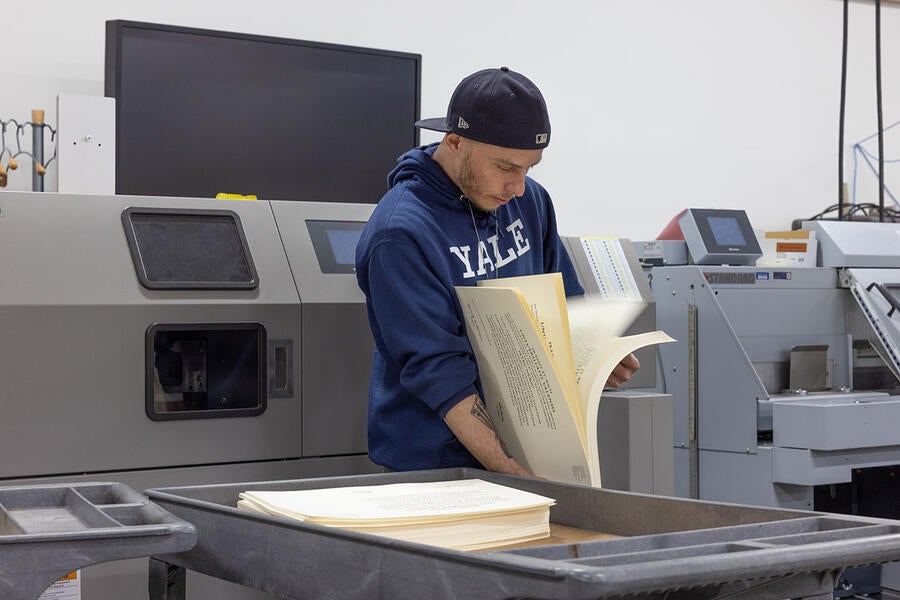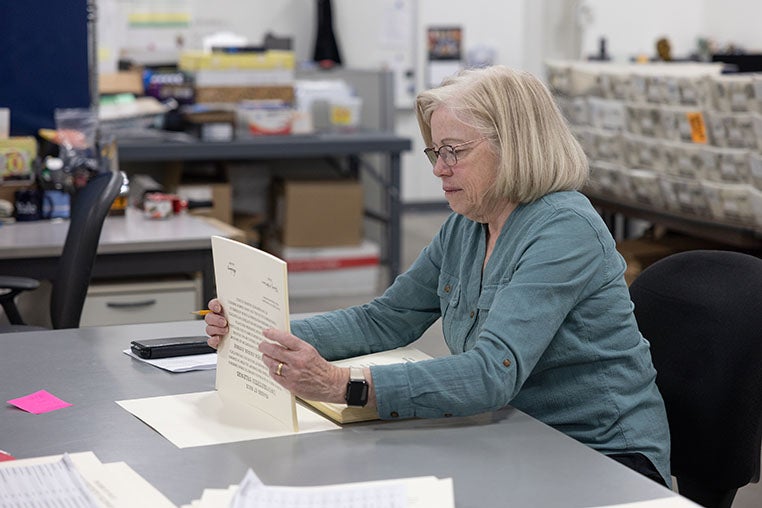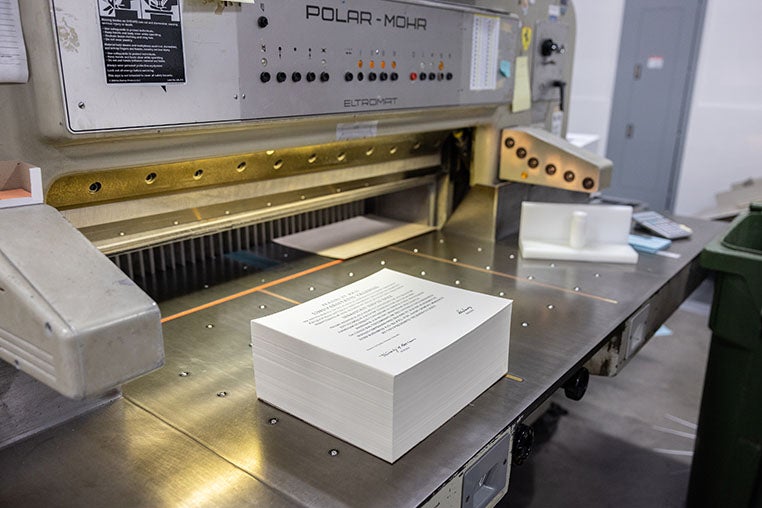
Each Yale Commencement, thousands of diplomas — printed in Latin, embossed with the Yale seal, and encased in a blue-linen holder — are received by newly minted graduates of Yale College and the graduate and professional schools. For students, these documents represent years of intensive study and research. For the staff that create them, the diplomas are a testament to teamwork — from planning and proofing to printing and delivering.
Since the mid-1990s, responsibility for printing Yale diplomas has resided with Yale Printing and Publishing Services (YPPS), in partnership with the Office of the Secretary and Vice President for Student Life (Office of the Secretary) and, more recently, the University Registrar’s Office. The process begins in early May, when diplomas for the professional schools and the Graduate School of Arts & Sciences (GSAS) are printed. Yale College diplomas, which reflect honors and distinctions calculated in the final days of the term, are prepared the Friday before Commencement.
“Just knowing that some of these graduates will become leaders in their fields, whether law, business, environment, medicine, politics or the stage and screen, is pretty amazing,” said John Poitras, production coordinator for Yale Printing and Publishing Services. “In this unobstrusive yet important role, YPPS has helped these students throughout their academic life at Yale. Our staff understands the significance of that role and are very proud to be part of this tradition.”
 Barbara Botti, from the Registrar’s Office, compares a Yale College diploma against the latest information in the university’s records; Photo by Robert DeSanto.
Barbara Botti, from the Registrar’s Office, compares a Yale College diploma against the latest information in the university’s records; Photo by Robert DeSanto.
Becoming fluent in “Yale diploma Latin”
Making sure each diploma reflects the right student information, such as the correct spelling of name, degree type, and honor or distinctions, requires multiple rounds of scrutiny — first the records that the registrar’s office provides to YPPS, then the digital proofs of each diploma for the graduate and professional schools, which are sent back to the registrar staff to confirm. Yale College diplomas are proofread in person at YPPS by the registrar’s team.
Diploma translations
Yale University now offers Certified Electronic Diplomas and Certificates to graduates. The electronic diploma includes a validation link that provides degree information in English.
Reviewing in another language initially seemed daunting, said Kory Riddle, associate university registrar, whose team took over the process from the Office of the Secretary in 2020. But the staff quickly became, as they say, “fluent in Yale diploma Latin.” (It also helps, noted Riddle, that the Latin text is generally consistent across every document.)
Once the digital proofs are approved, YPPS loads their digital presses with Mohawk superfine, smooth stock, embossed with the official Yale diploma seal. It takes about two hours to print the roughly 1,500 Yale College diplomas, organized by residential college.
Before the diplomas are trimmed, stacked, and shrink-wrapped into bundles, members of the Registrar’s Office arrive at YPPS to review them one by one — looking for inconsistencies such as misspelled names, or honors or distinction not properly translated into Latin. “The whole process takes us until about 9:30 p.m. (and sometimes later) the Friday of Commencement weekend, as the registrar’s information may be updated at the last minute,” said Jason England, associate director of pre-production and customer and design services at YPPS. “We stand by as they proof the diplomas in case some need to be reprinted. Some years we have to reprint a few; other times, a dozen or more.”
After the final check, all the diplomas are transported to the Registrar’s Office, which holds them pending any last-minute updates. Sunday morning, the bundles are delivered to the residential colleges. They are then carefully inserted into blue-linen holders by the dean’s office staff and readied for each school’s ceremony on Monday, held after the university-wide Old Campus event.
“Receiving a diploma from Yale is a life-changing moment. At YPPS, we are honored to play such an important role in an event that impacts the lives of students, parents, and families,” said Lisa Scott, the YPPS director. “It’s an exciting time of year for our staff, and we feel proud of our contributions to such a monumental event.”
 A stack of Yale College diplomas after being trimmed to their final size by Patrick Porto of YPPS; Photo by Robert DeSanto.
A stack of Yale College diplomas after being trimmed to their final size by Patrick Porto of YPPS; Photo by Robert DeSanto.
The digital evolution
Until 2019, the process was considerably slower, more laborious, and produced greater waste. Proofs called “paper dummies” were printed of every diploma and event program, and members of the Office of the Secretary would review them, page by page. “There were years we stayed at it until midnight, printing the diplomas or reprinting an adjusted program booklet,” said John.
The transition to a digital process and in-person proofing versus paper-dummy proofing was accelerated by the COVID-19 pandemic, which forced the 2020 graduation events to go virtual; that year, diplomas were mailed to graduates. (In 2022, the university hosted an in-person alumni commencement for these graduates, for which YPPS printed programs.)
By the numbers:
- 19,000 Commencement programs and tickets
- 7,500 Baccalaureate programs
- 10,000 Class Day programs
- 4,308 diplomas (1,436 Yale College; 2,872 graduate and professional schools)
- 4,000 unclaimed diplomas (stored in the Registrar’s Office) dating back to 1970
To produce that year’s diploma while maintaining health and safety protocols, YPPS, in conjunction with the Office of the Secretary and the Registrar’s Office, developed the digital proofing process they use today. They also helped create the Yale2020 website, where much of the commencement, baccalaureate, and Class Day-related information, once printed on paper, could be posted. (The project later earned YPPS, along with collaborators, a Linda K. Lorimer Award.) The transition meant not only a greener ceremony — reducing the commencement program from 52 pages to six — but fewer last-minute adjustments.
YPPS also produces a wide variety of other items for the three-day weekend, including honorary degrees and citations. In addition, they manage the development and production of individual programs, posters, and signage for all the residential colleges and professional schools’ graduation ceremonies and, upon request, procure giveaways like mugs, tote bags, or pins. This year, for the first time, they also distributed tickets for the Old Campus Commencement ceremony.
The next evolution? The diploma’s fonts. YPPS is working with the Office of the University Printer on a modern remake, to debut in 2024.
More to Know
Diplomas were once produced lithographically from a stone carving, with names handwritten in by a calligrapher, according to Michael Lotstein, university archivist at the Beinecke Rare Book and Manuscript Library. And Latin had a near-miss: in 1925, a letter from the Office of the Secretary discussed the desire to change the diploma’s language to English.






